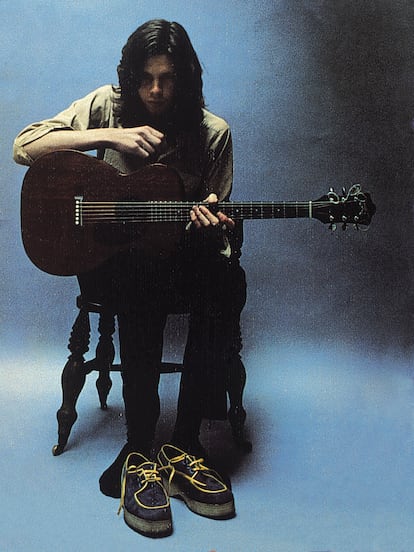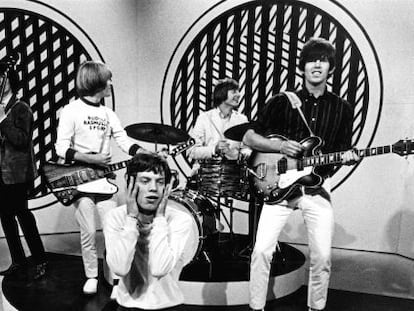Nick Drake: The mystery of the saddest, loneliest boy is still alive
A comprehensive official biography and a double tribute album reignite interest in the ultra-sensitive bard who died at 26. This summer he would have turned 75

Few obituaries were written at the end of November 1974 for Nick Drake, and even fewer tears were shed for the very early loss (at 26) of the best imaginable portraitist of grief, that fragile and beautiful boy who died one night of lightning and sleeplessness, the victim of a fatal combination of antidepressants. Perhaps Nicholas Rodney Drake himself would be the first to be surprised by the legendary dimension that his figure acquired over the years, becoming synonymous with masculine hypersensitivity, abysses of the soul and, above all, a very personal troubadouresque inspiration that the world had never seen before and which has spawned all sorts of emulators: from his contemporary John Martyn to that grief-stricken generation made up by Iron & Wine, Vetiver, Elliott Smith, Jeff Buckley, Bon Iver, Grizzly Bear and Sondre Lerche, to name a few.
We find ourselves before an artist who barely had time to record three albums in his lifetime, and whose legacy — including some other scattered pieces and even the occasional rough draft found among his home recordings — does not even amount to 50 songs. We are talking about an elusive, self-absorbed boy who was terrified of the stage and of whom there is not a single audiovisual testimony, be it in sound or photographic form, of the very few occasions when he did appear before an audience. A misunderstood, reclusive genius, a creator far ahead of his time (surely ours, too), Drake gradually retreated into his own ghosts, and the world didn’t take notice.
Little did it help that Mick Jagger himself became obsessed with his talent and magnetism (“come see us in London anytime”) after a chance meeting between Nick and the Rolling Stones in Marrakesh during the spring of 1967. It also wasn’t enough being taken under the wing of producer Joe Boyd, discoverer and the man in charge of the already dazzling Pink Floyd. Despite his packed schedule, after listening to Drake (he did enjoy that privilege) on December 21, 1967, at London’s Roundhouse, Boyd decided to support his career. In his autobiography, White Bicycles, he sums up in one phrase the way people felt upon discovering Nick: “He kept scratching his head,” he wrote about someone who had just met him, “as if trying to figure out what planet this kid was from.”
In the summer that Drake would have turned 75, two beautiful and heartfelt tributes to his fleeting but enduring career converge in stores. First there is The Life, a mammoth official biography (nearly 600 pages) by Richard Morton Jack, which the artist’s only sister, Gabrielle Drake, considers “definitive.” For us, however, the double album The Endless Colored Ways, in which 25 artists revisit and reinvent 25 songs from the albums Five Leaves Left (1969), Bryter Layter (1970) and Pink Moon (1972), is even more substantial — even if, in an effort to squeeze Drake’s meager catalog, the fantastic singer-songwriter from Birmingham Katherine Priddy ends up with They’re Leaving Me Behind, which was only recorded on a domestic cassette tape.
Recreating Drake’s singular work, so peculiar for his pained voice and the abundant unconventional tunings he used on his guitar, was never easy. The best thing about this anthology — by far the most extensive and ambitious effort to date — is that each participant applies their own sound and ideas, but without turning their backs on the intricate melodic and harmonic framework of the originals. Thus, the short-fused Fontaines D.C. take the immortal Cello Song to postpunk territory (believe it or not), just as the restless Mike Lindsay uses the deep, imploring voice of Guy Garvey (Elbow) to enlarge the legend of the beautiful Saturday Sun, that piece that condensed stupor and vital paralysis in those moving verses: “Saturday sun came without warning / So no-one knew what to do.”
Some are obvious, confessed admirers of Drake (John Grant, Philip Selway, Liz Phair), but there are also twists like Let’s Eat Grandma taking From the Morning closer to the territories of synth pop. We are still wondering if maybe the Norwegian Aurora didn’t disfigure the revered Pink Moon beyond recognition, and have a strong feeling that if he was still here, Nick Drake would embrace David Gray — who is impressive in his moving approach to Place to Be, peppered with a pinch of electronic — as his heir. It is but a mere dialectical device, true, but with Nicholas Rodney the notion that early, sudden deaths deprive us forever of dozens of titles that will never exist becomes unbearable.
Sign up for our weekly newsletter to get more English-language news coverage from EL PAÍS USA Edition
Tu suscripción se está usando en otro dispositivo
¿Quieres añadir otro usuario a tu suscripción?
Si continúas leyendo en este dispositivo, no se podrá leer en el otro.
FlechaTu suscripción se está usando en otro dispositivo y solo puedes acceder a EL PAÍS desde un dispositivo a la vez.
Si quieres compartir tu cuenta, cambia tu suscripción a la modalidad Premium, así podrás añadir otro usuario. Cada uno accederá con su propia cuenta de email, lo que os permitirá personalizar vuestra experiencia en EL PAÍS.
¿Tienes una suscripción de empresa? Accede aquí para contratar más cuentas.
En el caso de no saber quién está usando tu cuenta, te recomendamos cambiar tu contraseña aquí.
Si decides continuar compartiendo tu cuenta, este mensaje se mostrará en tu dispositivo y en el de la otra persona que está usando tu cuenta de forma indefinida, afectando a tu experiencia de lectura. Puedes consultar aquí los términos y condiciones de la suscripción digital.
More information
Archived In
Últimas noticias
Most viewed
- Sinaloa Cartel war is taking its toll on Los Chapitos
- Oona Chaplin: ‘I told James Cameron that I was living in a treehouse and starting a permaculture project with a friend’
- Reinhard Genzel, Nobel laureate in physics: ‘One-minute videos will never give you the truth’
- Why the price of coffee has skyrocketed: from Brazilian plantations to specialty coffee houses
- Silver prices are going crazy: This is what’s fueling the rally











































